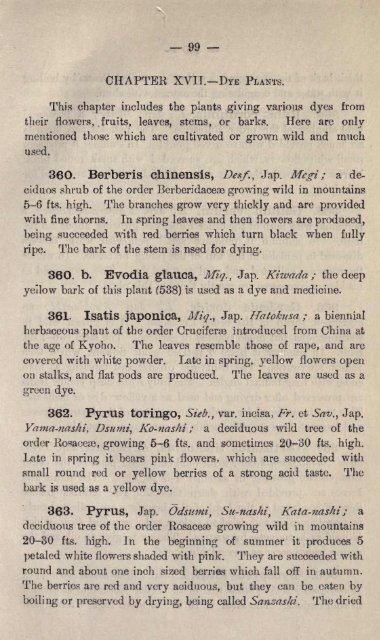Untitled - Library
Untitled - Library
Untitled - Library
Create successful ePaper yourself
Turn your PDF publications into a flip-book with our unique Google optimized e-Paper software.
99<br />
CHAPTER XVIL<br />
DYE PLANTS.<br />
This chapter includes the plants giving various dyes from<br />
their flowers, fruits, leaves, stems, or barks. Here are only<br />
mentioned those which are cultivated or grown wild and much<br />
qsed,<br />
36O. Berberis chinensis, Desf., Jap. Megi ; a deciduos<br />
shrub of the order Berberidaceae growing wild in mountains<br />
5-6 fts. high. The branches grow very thickly and are provided<br />
with fine thorns. In spring leaves and then flowers are produced,<br />
being succeeded with red berries which turn black when fully<br />
ripe.<br />
The bark of the stem is nsed for dying.<br />
06 O. b. Evodia glauca, Miq., Jap. Kiwada ; the deep<br />
yeilow bark of this plant (538) is used as a dye and medicine.<br />
361. Isatis japonica, Miq., Jap. Hatokusa ; a biennial<br />
herbaceous plant of the order Cruciferae<br />
introduced from China at<br />
the age of Kyoho. The leaves resemble those of rape, and are<br />
covered with white powder. Late in spring, yellow flowers open<br />
on stalks, and flat<br />
pods are produced. The leaves are used as a<br />
green dye.<br />
362. Pyrus toringo, Sieb., var. incisa, Fr. et Sav., Jap.<br />
Yama-nashi, Dsuuii, Ko-nashi ; a deciduous wild tree of the<br />
order Kosaceae, growing 5-6 fts. and sometimes 20-30 fts.<br />
high.<br />
Lute in spring it bears pink flowers, which are succeeded with<br />
small round red or yellow berries of a strong<br />
bark is used as a yellow dye.<br />
acid taste. The<br />
363. PyrUS, Jap. Odsumi, Su-nashi<br />
y<br />
Kata-nashi ; a<br />
deciduous tree of the order Kosaceae growing wild in mountains<br />
20-30 fts.<br />
high. In the beginning of summer it produces 5<br />
petaled white flowers shaded with pink. They are succeeded with<br />
round and about one inch sized berries which fall off in autumn.<br />
The berries are red and very aciduous, but they can be eaten by<br />
boiling or preserved by drying, being called Sanzashi. The dried
















